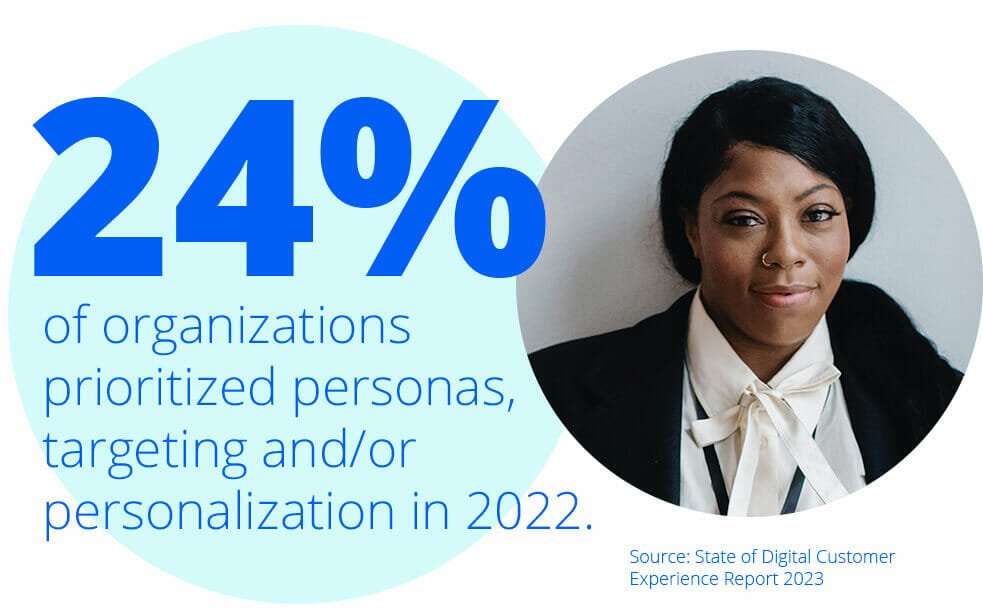Creative direct mail marketing is great for direct-to-consumer brands seeking to generate leads and Incremento de ventas in a particular area because it allows them to send tailored messages to potential customers in a more straightforward way that gets their attention.
Localization is one of the secret weapons to achieve this. Localizing direct mail campaigns can increase their effectiveness by adapting the content to different cultures. This can lead to higher response rates, resulting in more sales.
In fact, according to a study conducted by InfoTrends, 84% of consumers said that personalization increased the chances of them opening and reading direct mail.
But getting people to open the direct mail piece is not the key goal in many cases. What marketing teams are looking for is higher response rates that lead to sales.
In this article, you’ll understand the impact localization can have on your direct mail marketing strategy to boost responses and sales. You’ll also learn how to start with localization and how to combine it with personalized marketing techniques to achieve greater results.
What’s localization in direct mail marketing?
In direct mail marketing, localization means adjusting the message, design, and offers to fit the target language and culture of a certain area. As you’ll see in this article, from my experience, localization has a lot to do with personalization.
A successful localization strategy shares a common feature with a powerful personalization strategy: a deep understanding of the target audience’s context.
This is why 24% of organizations are prioritizing personalization.

It involves tailoring the content and design of direct mail pieces to ensure that they are relevant and meaningful to the target audience. This target audience can be as granular as you need.
This is where micro-segmentation can play a key role in a direct mail marketing strategy. Make sure to watch the following video to learn more about micro-segmentation in marketing.
3 common localization techniques in direct mail marketing
To achieve the ideal blend of localization and direct mail marketing, three key elements are crucial in devising an effective strategy.
- Translated message: To reach your audience, translate the direct mail into their language, so they can understand it easily. This will boost the likelihood of successful communication with your intended audience. For example, if you are targeting Hispanic audiences in the US, your message will be more effective if it is in Spanish.
- Adapting design elements: This involves using design elements, such as color schemes and imagery, that are culturally relevant to the target audience. For example, a direct mail campaign targeting customers in Morocco may use the colors red and green, which are their national colors.
- Localizing offers and incentives: This involves offering promotions and incentives that are tailored to the local market based on what they value most. For example, a direct mail campaign targeting customers in the United States during the Fourth of July holiday may offer a discount on patriotic-themed merchandise.
What’s the difference between localization and personalization?
The main difference between localization and personalization is that localization focuses on adapting messaging and design to specific geographic locations, while personalization focuses on adapting messaging, experience and design to individual recipients.
So, localization focuses on common cultural facts regarding a target audience, while personalization focuses on the information available about a person.
However, as I mentioned earlier, effective localization and personalization strategies are focused on the audience’s context. No matter the size of the audience.
Both marketing strategies can coexist. In fact, if you use them both, your marketing and advertising efforts will be more effective.
For example, I wrote a case study about a car brand that increased its response rate by 500% with tailored messages and personalized touches in a direct mail campaign.
Even better, they added personalización de vídeo to the equation, catching their audience’s attention and increasing engagement as a result.
While both techniques can improve the effectiveness of direct mail marketing, localization is particularly important for reaching diverse audiences across different regions and cultures.
The reason for this is that personalization does require having access to more lead or customer data to effectively craft the right message and experience.
Now, let’s cover why localization is behind many of the best direct mail marketing initiatives. Understanding the value of localization in your direct mail campaigns will help you know if you should localize your direct mail marketing.
Benefits of Localization in Direct Mail Marketing
Through the years, we’ve seen the power of localization in direct mail marketing. This has been particularly significant for brands that target potential customers that are part of a particular country within a specific geographic area.
For example, did you know that there are over 50 million overseas Chinese? Other cultures that come to mind are Latinos in the US, Moroccans in France or even French people in Morocco.
Let me share another example. This time, a personal one.
I’m originally from Panama. Back in my teenage years, we lived in Morocco for a few years. Back then, about 27 million people lived in Morocco. Six of them were from Panama.
Almost any localized message that met our needs, concerns, and desires would have been extremely effective.
Obviously, my family was not a good segment for any brand trying to reach out to Panamenians in the country. However, this serves as an example of the benefits of localization in direct mail marketing. At scale.
But there are many more.
By adapting messaging and design to the cultural norms and linguistic preferences of your potential customers within a specific geographic location, your business can achieve the following benefits:
Improved Response Rates
A study by Epsilon found that localized direct mail campaigns can generate up to 7 times higher response rates compared to non-localized campaigns.
Then, personalized and localized direct mail campaigns have been shown to have higher response rates than non-personalized or non-localized campaigns.
This is because localized campaigns are more relevant and meaningful to the target audience, which increases the likelihood that they will respond.
Increased Customer Engagement
By tailoring messaging and offers to the preferences and needs of the target audience, businesses can create direct mail pieces that are more engaging and appealing.
However, bear in mind that this requires a creative effort. Today’s audiences are constantly bombarded with irrelevant messages. As a result, they pay less attention to the majority of them, simply because we can’t certainly pay attention to everything we see and hear.
Because of this, any localization strategy in direct mail marketing should pay close attention to the quality of the content. This content must be appealing, relevant, and specific.
This can lead to increased customer engagement and higher levels of interest in the product or service being offered.
Now, here is something every marketer should remember. Customer engagement comes after the sum of one or many great customer experiences.
This is why about 52% of consumers spend much more time reviewing printed direct mail pieces when they are personalized and relevant, according to Infotrends.
Then, to get better response rates, combine localization with personalization in your direct mail strategy.
Greater Brand Loyalty
When businesses demonstrate an understanding of the local culture and preferences, it can create a sense of trust and loyalty even among to-become customers. The earlier you start working on customer loyalty, the better.
When businesses demonstrate their commitment to the community and show that they genuinely comprehend the distinctive desires and interests of their customers, it sets the stage for cultivating enduring connections marked by unwavering customer loyalty.
If you work in B2B marketing and value customer loyalty, I wrote an article that explains how personalized video marketing can improve your brand’s customer loyalty.
Make sure to read the article to learn how you can leverage video personalization in your B2B marketing to boost customer loyalty.
Aquí hay un ejemplo de video personalizado:
By using personalized videos to deliver a better customer experience, you can boost your customers’ loyalty.
Side note: Using personalized videos in your marketing is not a synonym of success. Just like any marketing strategy, there are many things that could go wrong.
This is why I wrote an article focused on 5 critical mistakes every brand should avoid when personalizing videos in marketing. Make sure to take a look at it, especially if you are entering the personalized marketing world to boost audience engagement.
Positive Impact on Reputation
By creating localized direct mail campaigns that are culturally sensitive and relevant, businesses can enhance their reputation and brand image.
Customers are more likely to view businesses that prioritize localization as respectful and trustworthy, which can ultimately lead to increased sales and customer retention.
In summary, localization in direct mail marketing can have a significant impact on response rates, customer engagement, brand loyalty, and reputation. By investing in localization, businesses can create more effective and meaningful campaigns that resonate with their target audience and drive business growth.
Understanding the Target Audience
Any marketer knows about the importance of audience segmentation when crafting any campaign. But the truth is, in many cases people tend to forget about ensuring they are targeting the right audience and instead focus on other obvious things such as marketing messages.
To succeed in your localization project in direct mail marketing, it is important to have a deep understanding of the target audience. Otherwise, you’ll end up with a beautifully crafted direct mail piece that is thrown in the trash in no time.
Here are some key points to keep in mind when segmenting your audience for a localized direct mail campaign:
Know your audience
Identify the specific characteristics and preferences of your audience, including demographics, psychographics, and behaviors. This can be particularly challenging if you don’t have experience with at least one international audience.
For instance, I’ve lived in Panama, Costa Rica, Morocco, and Spain. Since I was a kid, I’ve been surrounded by different cultures. Even in my family unit, we have a mix of cultures.
During these years, I’ve found that people with similar backgrounds are more sensitive to the different cultural realities around them. As a result, they can use this knowledge to understand other people better and then communicate with them.
Taking the time to know what your potential customers think is crucial for the success of your localized direct mail marketing. For example, among Spanish-speaking countries, the same word can have different meanings.
But the same applies to what each culture values, their aspirations, and even their decision-making process.
Take the time to understand your target audience.
Importance of Audience Segmentation
Audience segmentation is the process of dividing a larger audience into smaller groups based on shared characteristics. When you segment your audience, you create more targeted and relevant messaging and offers, which can lead to higher response rates and greater ROI.
Here are 7 easy ways to segment your audience for your localization strategy in direct mail marketing:
- By demographics: Analice quiénes son sus clientes en función de criterios como la edad, los ingresos, el número de miembros de la familia, la raza, el género, la ocupación, la educación y la nacionalidad.
- By skills and knowledge: Study your customers’ skills and knowledge in relation to how they interact with your brand, employees, products, and services.
- By preferences: Divide your customer base taking into account the things your potential customers like about your brand, products, and services.
- By behavioral activities: Analiza los comportamientos y procesos de toma de decisiones que siguen tus clientes. Por ejemplo, piense en su estilo de vida, cómo, cuándo y por qué compran, y más.
- By psychographics: This takes into account how your customers think and divide markets according to the lifestyle, personality traits, values, opinions, and interests of consumers.
- By how your potential customers may use your product: ¿Utilizan su producto como esperaba inicialmente? ¿Cuándo lo usan? ¿Con otras personas?
- By how they could buy and pay: Similar to behavioral activities, looking at their processes, how much they spend, when they buy, from what device, if they buy based on a special promotion, and more.
Techniques for Identifying the Target Audience in localized direct mail marketing
There are several techniques for identifying your target audience, including conducting market research, analyzing customer data, and studying competitors.
It is important to gather as much data as possible on your target audience to better understand their needs, preferences, and behaviors. In fact, Accenture reports that 32% of companies see tangible value from data.

This often applies to big firms with intelligence departments. But if doesn’t have to be like that. Use the data you have access to.
By analyzing your target audience, you can create highly targeted and effective campaigns that resonate with your ideal customers. This can increase response rates, improve ROI, and greater customer engagement and loyalty.
To identify the target audience in localized direct mail marketing, you can use the following techniques:
- Conduct market research: Market research involves collecting data on the market and target audience. This can be done through surveys, focus groups, or secondary research such as analyzing industry reports. Market research can provide valuable insights into the needs, preferences, and behaviors of the target audience. My best advice: Go and talk to people.
- Analyze customer data: Based on your current customers, analyzing customer data can help businesses understand the characteristics and behaviors of potential customers with common characteristics. This includes demographic information, purchasing behavior, and customer feedback. By analyzing customer data, your business can identify common characteristics among potential customers and tailor your marketing efforts accordingly.
- Study competitors: Studying competitors involves analyzing the marketing strategies of similar businesses in the industry. This can provide insights into the target audience and what marketing tactics are most effective. By studying competitors, you can identify gaps in the market and opportunities to differentiate their marketing efforts.
These techniques to identify your target audience will also help you build the right marketing material if you are launching a new product. It can provide valuable insights into the target audience in localized direct mail marketing.
When you combine market research, customer data analysis, and competitor analysis, you can create campaigns that target your ideal customers effectively. As a result, you’ll lead your company to growth and success.
Challenges in Localizing Direct Mail Marketing
When it comes to direct mail campaigns, the localization process demands meticulous planning and thoughtful consideration. Proper planning and consideration are crucial to ensure your message resonates with your target audience.
To make sure you succeed, consider factors like cultural differences, language barriers, legal requirements, and budget limitations when localizing the content.
- Cultural Differences: Cultural differences can have a significant impact on the success of a direct mail marketing campaign. What works in one country or region may not work in another. It is important to consider cultural nuances and adapt messaging and design accordingly.
- Language Barriers: Language barriers can also present a challenge when localizing direct mail marketing. It is important to ensure that the language used in the direct mail piece is appropriate and understandable to the target audience. This may involve translating the messaging into different languages or using local dialects or idioms.
- Legal Requirements: Legal requirements can vary by country or region and may impact the messaging and design of the direct mail piece. It is important to research and comply with local regulations related to advertising and marketing.
- Budget Constraints: Localizing direct mail marketing can be costly, particularly when it comes to translation and design. Budget constraints can limit the resources available for localization efforts, which may impact the effectiveness of the campaign.
How to Overcome the Challenges of Localization
Since localization pays back, let’s now cover how you can overcome these challenges.
- Professional Translation Services for Direct Mail: To ensure your direct mail piece is accurately translated and appropriate for your target audience, consider hiring professional translation services. It is important to work with experienced translators who are familiar with the nuances of the target language and culture.
- Conducting Extensive Market Research: Conducting extensive market research can provide valuable insights into the target audience, including cultural nuances, language preferences, and purchasing behaviors. This information can inform the design and messaging of the direct mail piece, ensuring that it resonates with the target audience.
- Creating a Localization Strategy: Creating a localization strategy involves developing a plan for adapting the direct mail piece to the target audience. This may involve translating the messaging into different languages, adapting the design to local cultural norms, and complying with local legal requirements. A well-defined localization strategy can help ensure the direct mail piece is effective and resonates with the target audience.
- Working Within a Realistic Budget: Working within a realistic budget is important when localizing direct mail marketing. Marketers must be mindful of the costs associated with translation, design, and printing, and must prioritize their efforts to ensure that resources are allocated effectively. This may involve focusing on the most important markets or prioritizing certain localization efforts over others.
Measuring the Effectiveness of Localized Direct Mail Marketing
As a marketer, it is important to measure the effectiveness of localized direct mail marketing campaigns to determine their impact and ROI. Here are some key metrics to consider:
- Metrics for Measuring Response Rates: Response rates can be used to measure the effectiveness of direct mail campaigns. To track email effectiveness, measure the number of replies, response rate as a percentage of total sent emails, and conversion rate as the percentage of replies that result in a sale.
- Metrics for Measuring Customer Engagement: Customer engagement is an important metric for measuring the effectiveness of direct mail campaigns. To gauge the success of your campaign, you can examine website visits, social media engagement, and the length of incoming phone calls, and evaluate the quality of responses from web forms. Also, consider measuring customer satisfaction and loyalty after purchase.
- Metrics for Measuring Brand Loyalty: Brand loyalty is an important metric for measuring the effectiveness of direct mail campaigns over the long term. This can include metrics such as repeat purchases, customer retention rates, and the number of referrals or recommendations received.
- ROI and Profitability Metrics: Measuring ROI and profitability is important for assessing the overall effectiveness of direct mail campaigns. This can include metrics such as the cost per acquisition (CPA), ROI, and the total profit generated by the campaign.
Marketers can understand how effective their direct mail campaigns are by tracking these metrics. This helps them to make informed decisions on maximizing their marketing strategies for the best results and ROI.
8 key considerations for successful localized direct mail marketing
There are 8 considerations for a successful localized direct mail marketing campaign.
Define clear campaign goals
Before launching any direct mail campaign with localization, it’s essential to define clear campaign goals. Your goals should be specific, measurable, achievable, relevant, and time-bound.
For example, your goal might be to generate 100 new leads in a specific geographic area within the next 30 days.
Defining clear campaign goals helps you to:
- Focus your message and offer on your target audience’s needs and interests
- Select the most effective mailing list and targeting criteria
- Determine the appropriate budget and resources needed to achieve your goals
- Measure the success of your campaign and make data-driven decisions for future campaigns.
Make sure your goals align with your overall marketing and business objectives. By defining clear campaign goals, you can increase the effectiveness of your direct mail campaign and generate more leads and sales.
Define your target audience
As I covered earlier, who are the people you want to reach? What are their interests, needs, and preferences? What’s their cultural background? These are some of the questions that you should answer.
By understanding your target audience, you can tailor your message and offer to their specific needs and interests, increasing the likelihood of a response.
Develop your mailing list
Once you have defined your goals and target audience, you need to develop a mailing list.
There are various ways to do this. You can purchase a list from a reliable provider, use your own customer database, or partner with a nearby business or organization to exchange mailing lists.
Whatever method you choose, make sure your list is accurate, and up-to-date, and includes the names and addresses of your target audience.
Create a compelling offer
To make your direct mail campaign successful, you need to offer something that your target audience wants or needs. This needs to be culturally relevant.
This can be a discount, a free trial, a limited-time offer, or any other incentive that will motivate them to respond. Make sure your offer is clear, concise, and easy to understand, and include a call-to-action that tells your audience what to do next.
Design your mail piece
The design of your mail piece is critical to the success of your campaign. It should be visually appealing, easy to read, and reflect your brand’s personality and values.
Use high-quality images and graphics, and make sure your message and offer are prominently displayed. Keep your design simple and uncluttered, and use white space to make your message stand out.
Similar to when you create a compelling offer, make sure your call-to-action is attractive, not only visually.
For example, find something your target audience values. Something they really want to get in exchange for either their time or their money.
Use personalization
As we covered, personalization can significantly increase the effectiveness of your direct mail campaign. When available, use your target audience’s name in the address line and throughout your mail piece.
But, when possible, do even more. Remember that your target audience already knows their name. Using their first name is a good way to catch their attention. But if you use more data points to make the message more relevant, you’ll get them closer to taking action.
Personalization will sometimes be obvious. But I’ve found that on many occasions, for the message to be even more effective, you need to help the potential customer understand what the data means to them.
For example, if you are in real estate marketing, you can target by average income with the average aspirations of customers similar to them.
Similarly, if your target audience has kids, you can use that fact in your copy and creative content to make it more appealing.
Personalize your message and offer to their specific interests and needs, and make sure your mail piece looks like it was designed specifically for them.
Select the right printing and mailing services
Look for a reputable company that offers high-quality printing, accurate addressing, and timely mailing services. Choosing the right printing and mailing services can save you time, money, and hassle.
Make sure they can handle your specific requirements, such as variable data printing, custom sizes, and unique folding options.
Test and measure your campaign
Testing and measuring your campaign is critical to its success. Use A/B testing to compare different versions of your mail piece and measure their response rates.
Track your campaign’s results using tools like unique phone numbers, landing pages, and coupon codes. Use this data to refine your message.
Make sure to use add a digital way to convert leads. For example, use QR codes, landing pages, phone numbers, and more, since it can help you track the effectiveness of your message and creative content.
A real-Life example of a creative and effective localized direct mail marketing campaign
In this case study, I will describe how a well-known car brand used localization and personalization to achieve the best results ever in a direct mail campaign.
You can replicate their success by strategically using localization and personalization in your next direct mail campaign.
This case study is a vivid example of what Wyzowl found in a survey. 94% of marketers say video has helped them increase their understanding of a product or service. Audiences love videos. And personalized videos are even more effective than generic videos.

Going away from ineffective direct mail campaigns
Many direct mail campaigns are boring and don’t get the target’s attention. Knowing this, the manager in charge of customer relations for a popular car company intended to improve the response rates by contacting a particular mail list through clever and creative direct mail marketing.
But he realized that the brand needed to go away from ineffective direct mail campaigns that don’t get leads’ responses.
He wanted to move these leads from physical to digital so that they could better target them in the future through digital channels. He also wanted to gather more customer data to improve future interactions and engagement.
Adding a strong call-to-action to a direct mail piece
The CRM manager for this automotive company found that using vídeos personalizados was an effective way to stand out from competitors and encourage contacts to take action fast.
The reason for this is that the majority of consumers prefer video to other types of content. This is why personalized videos and interactive videos are some of the main video marketing trends to watch out for.
The personalized video would feature a local celebrity speaking in their local language and would be placed in a página de inicio personalizada with a web form to request a book.
Then, by using personalized videos and other creative content, the brand would give the email list a compelling reason to move forward in the sales process.
Personalized video is a type of video created using customer data such as the recipient’s name, location, or product preferences. It is also known as a data-driven video.
They just needed to find the appropriate personalized video software and service team who could support them, especially since they lacked experience in personalized video marketing.
Partnering with Pirsonal to make personalized videos for direct mail marketing
To make personalized videos automatically, they needed a partner that could adapt to their needs, timeline, expertise, and audience size. After analyzing different potential vendors, they selected Pirsonal.
In Pirsonal, they found a partner that could use their branded video to make personalized videos for potential customers at scale. They also found a partner that could create the videos at speed so that they could deliver the campaign on time.
So, the CRM manager found personalized video software and a Professional Services team to help them achieve success based on their needs, audience size, and workflow.
To fasten the creation of personalized video content securely, they used a spreadsheet with customer data to create data-driven videos from a spreadsheet.
Adding personalized videos to the direct mail pieces
Once the personalized videos were ready, they simply needed to add a QR code to the direct mail pieces. Below you’ll find an example (but it is not the real one for privacy reasons).
The CRM manager had the following workflow in mind:
- The brand would provide a branded video for personalization.
- Pirsonal would create a custom template for video personalization.
- The brand would provide an XSL file with the data for personalization.
- Pirsonal would render the videos in the cloud and provide an XLS file with the links.
- The brand would load this data into their direct mail software to send the campaign.
The process was smooth, frictionless, and fast. The CRM manager was able to meet his team’s needs without becoming an expert in personalized video marketing. He relied on Pirsonal’s team to lead the way and adapt to the needs of the brand at every step.
The highest response rate from a direct mail campaign
Just in the first few days, the campaign was a total success. They had the best response rate ever for this brand in that localized market.
There are three reasons for this success:
- Un excellent campaign execution from the CRM manager and his team.
- Innovating with creative direct mail marketing with personalized video campaigns.
- Flexible, scalable, and reliable personalized video software that matched their needs.
This helped them accomplish their goals through localized direct mail marketing with personalized videos.
This initiative allowed them to create more engaging email campaigns for the same audience while spending less on each contact compared to direct mail marketing.
Takeaways
Direct mail marketing is a highly targeted and effective marketing tool that businesses can use to reach potential customers directly in their homes. It can also be a cost-effective way to reach many people.
However, to make your direct mail campaign successful, you need to localize it. Localizing your campaign means targeting specific areas and demographics that are most likely to respond to your offer.
Thanks to personalization, brands can take their localized direct mail marketing to the next level. This is because they can target individuals based on their personal context and data.
As a result, messages are more effective, they deliver a better experience, engagement increases, and then response rates are superior.
Then, to see better results from your direct mail marketing initiative, make sure to prioritize localization and personalization.
Some creative approaches for effective direct mail marketing include creating a personalized video for each potential customer. With personalized videos, audiences engage and take action faster.
The majority of marketers and agencies don’t have experience with personalized video marketing. And most of the solutions in the market are either too limited or just too much.
At Pirsonal, we offer personalized video software that’s adaptable, expandable, and reliable. We also provide professional services to support your team in achieving your direct mail marketing goals.
Want to know more about how you can boost direct mail engagement with personalized videos in your next campaign? Hablemos. We’ll share more examples and case studies that adapt to your particular goals and requirements. We’ll also take the time to understand your needs and provide expert feedback to help you succeed.

